Evaluation of the Formability and Dimensional Accuracy Improvement of Ti6Al4V in Warm SPIF Processes
Abstract
:1. Introduction
2. Materials and Methods
2.1. Characterisation of the Material
2.2. SPIF Assays
2.3. FEM Simulation
3. Results
4. Discussion
5. Conclusions
Author Contributions
Funding
Acknowledgments
Conflicts of Interest
References
- Kopac, J.Z.; Kampus, Z. Incremental sheet metal forming on CNC milling machine-tool. J. Mater. Process. Technol. 2005, 162–163, 622–628. [Google Scholar] [CrossRef]
- Leszak, E. Apparatus and process for incremental dieless forming. U.S. Patent 3342051A, 19 September 1967. [Google Scholar]
- Emmens, W.C.; Sebastiani, G.; Van de Boogard, A.H. The tecnology of Incremental Sheet Forming. A brief rewiew of the history. J. Mater. Process. Technol. 2010, 210, 981–997. [Google Scholar] [CrossRef]
- Behera, A.K.; De Sousa, R.A.; Ingarao, G.; Oleksik, V. Single point incremental forming: An assessment of the progress and technology trends from 2005 to 2015. J. Manuf. Process. 2017, 27, 37–62. [Google Scholar] [CrossRef] [Green Version]
- Ambrogio, G.; Gagliardi, F.; Bruschi, S.; Filice, L. On the high-speed Single Point Incremental Forming of titanium alloys. Man. Tech. 2013, 62, 243–246. [Google Scholar] [CrossRef]
- Hussain, G.; Gao, L.; Hayat, N.; Cui, Z.; Pang, Y.C.; Dar, N.U. Tool and lubrication for negative incremental forming of a commercially pure titanium alloy sheet. J. Mater. Process. Technol. 2008, 203, 193–201. [Google Scholar] [CrossRef]
- Allwood, J.; King, G.P.F.; Duflou, J. A structured search for applications of the incremental sheet-forming process by product segmentation. Proc. Inst. Mech. Eng. Part B-J. Eng. Manuf. 2004, 219, 239–244. [Google Scholar] [CrossRef]
- Schaeffer, L.; Castelan, J.; Gruber, V.; Daleffe, A.; Marcelino, R. Development of customized products through the use of incremental sheet forming for medical orthopaedic applications. In Proceedings of the 3rd International Conference on Integrity, Realiability and Failure, Porto, Portugal, 20–24 July 2009. [Google Scholar]
- Eksteen, P.D.; Van der Merwe, A.F. Incremental sheet forming (ISF) in the manufacturing of titanium based plate implants in the bio-medical sector. In Proceedings of the CIE42 Proceedings, Cape Town, South Africa, 16–18 July 2012. [Google Scholar]
- Araújo, P.; Teixeira, L.; Montanari, A.; Reis, A.; Silva, M.B.; Martins, P.A.F. Single point incremental forming of a facial implant. Prosthet Orthot Int. 2014, 38, 369–378. [Google Scholar] [CrossRef] [PubMed]
- Vanhove, H.; Carette, Y.; Vancleef, S.; Duflou, J.R. Production of thin shell clavicle implants through single point incremental forming. Procedia Eng. 2017, 183, 174–179. [Google Scholar] [CrossRef]
- Tanaka, S.; Nakamura, T.; Hayakawa, K.; Nakamura, H.; Motomura, K. Incremental Sheet Metal Forming Process for Pure Titanium Denture Plate. In Proceedings of the 8th ICTP, Advanced Technology of Plasticity Proceedings, Verona, Italy, 9–13 October 2005; pp. 135–136. [Google Scholar]
- Ambrogio, G.; De Napoli, L.; Filice, L.; Gagliardi, F.; Muzzupappa, M. Application of incremental forming process for high customized medical product manufacturing. J. Mater. Process. Technol. 2005, 162–163, 156–162. [Google Scholar] [CrossRef]
- Badr, O.M.; Rolfe, B.; Hodgson, P.M.; Weiss, M. Forming of high strength titanium sheet at room temperature. Mater. Des. 2015, 66, 618–626. [Google Scholar] [CrossRef]
- Duflou, J.R.; Callebaut, B.; Verbert, J.; De Baerdemaeker, H. Laser assisted incremental forming: Formability and accuracy improvement. Ann. CIRP 2007, 56, 273–276. [Google Scholar] [CrossRef]
- Duflou, J.R.; Callebaut, B.; Verbert, J.; De Baerdemaeker, H. Improved SPIF performance through dynamic local heating. Int. J. Mach. Tools Manuf. 2008, 48, 543–549. [Google Scholar] [CrossRef] [Green Version]
- Götmann, A.; Bailly, D.; Bergweiler, G.; Bambach, M.; Stollenwerk, J.; Hirt, G.; Loosen, P. A novel approach for temperature control in ISF supported by laser and resistance and resistance heating. Int. J. Adv. Manuf. Technol. 2013, 67, 2195–2205. [Google Scholar] [CrossRef]
- Götmann, A.; Diettrich, J.; Bergweiler, G.; Bambach, M.; Hirt, G.; Loosen, P.R.; Poprawe, R. Laser-assisted asymmetric incremental sheet forming of titanium sheet metal parts. Prod. Eng. 2011, 5, 263–271. [Google Scholar] [CrossRef]
- Fan, G.; Gao, L.; Hussain, G.; Zhaoli, W. Electric hot incremental forming: A novel technique. Int. J. Mach. Tools Manuf. 2008, 48, 1688–1692. [Google Scholar] [CrossRef]
- Fan, G.; Sun, F.; Meng, X.; Gao, L.; Tong, G. Electric hot incremental forming of Ti6Al4V titanium sheet. Int. J. Adv. Manuf. Technol. 2010, 49, 941–947. [Google Scholar] [CrossRef]
- Honarpisheh, M.; Abdolhoseini, M.J.; Amini, S. Experimental and numerical investigation of the hot incremental forming of Ti6Al4V using electrical current. Int. J. Adv. Manuf. Technol. 2016, 83, 2027–2037. [Google Scholar] [CrossRef]
- Ambrogio, G.; Filice, L.; Gagliardi, F. Formability of lightweight alloys by hot incremental sheet forming. Mater. Des. 2012, 34, 501–508. [Google Scholar] [CrossRef]
- Amini, S.; Ghaei, A. An experimental study on dimensional accuracy, surface quality, and hardness of Ti6Al4V titanium alloy sheet in hot incremental forming. Int. J. Adv. Manuf. Technol. 2016, 87, 3579–3588. [Google Scholar]
- Ambrogio, G.; Filice, L.; Manco, G.L. Warm incremental forming of magnesium alloy AZ31. CIRP Ann. Manuf. Technol. 2008, 57, 257–260. [Google Scholar] [CrossRef]
- Ambrogio, G.; Gagliardi, F.; Chamanfar, A.; Misiolek, W.; Filice, L. Induction heating and cryogenic cooling in single point incremental forming of Ti6Al4V: process setup and evolution of microstructure and mechanical properties. Int. J. Adv. Manuf. Technol. 2017, 91, 803–812. [Google Scholar] [CrossRef]
- Durante, M.; Formisano, A.; Langella, A.; Memola Capece Minutolo, F. The influence of tool rotation on an incremental forming process. J. Mat. Process. Technol. 2009, 209, 4621–4626. [Google Scholar] [CrossRef]
- Palumbo, G.; Brandizz, M. Experimental investigations on the single point incremental forming of a titanium alloy component combining static heating with high tool rotation speed. Mater. Des. 2012, 40, 43–51. [Google Scholar] [CrossRef]
- Ambrogio, G.; Filice, L.; Gagliardi, F. Improving industrial suitability of incremental sheet forming process. Int. J. Adv. Manuf. Technol. 2012, 58, 941–947. [Google Scholar] [CrossRef]
- Al-Ghamdi, K.; Hussain, G. The pillowing tendency of materials in single point incremental forming: Experimental and finite element analyses. Proc. Inst. Mech. Eng. B J. Eng. 2015, 229, 744–753. [Google Scholar] [CrossRef]
- Silva, M.B.; Skjoedt, M.; Atkins, A.G.; Bay, N.; Martins, P.A.F. Single-point incremental forming and formability-failure diagrams. J. Strain. Anal. Eng. 2008, 43, 15–35. [Google Scholar] [CrossRef]
- Henrard, C.; Bouffioux, C.; Eyckens, P.; Sol, H.; Duflou, J.R.; Van Houtte, P.; Van Bael, A.; Duchêne, L.; Habraken, A.M. Forming forces in single-point incremental forming: prediction by finite element simulations, validation and sensitivity. Comput. Mech. 2011, 47, 573–590. [Google Scholar] [CrossRef]
- He, S.; Van Bael, A.; Van Houtte, P.; Szekeres, A.; Duflou, J.R.; Henrard, C.; Habraken, A.M. Finite Element Modeling of Incremental Forming of Aluminum Sheets. Adv. Mater. Res. 2005, 6, 525–532. [Google Scholar] [CrossRef]
- Sena, J.I.V.; Lequesne, C.; Duchene, L.; Habraken, A.M.; Valente, R.A.F.; Alves de Sousa, R.J. Single point incremental forming simulation with adaptive remeshing technique using solid-shell elements. Eng. Comput. 2016, 33, 1388–1421. [Google Scholar] [CrossRef] [Green Version]
- Sena, J.I.V.; Guzmán, C.F.; Duchêne, L.; Habraken, A.M.; Behera, A.K.; Duflou, J.; Valente, R.A.F.; Alves de Sousa, R.J. Simulation of a two-slope pyramid made by SPIF using an adaptive remeshing method with solid-shell finite element. Int. J. Mater. Form. 2016, 9, 383–394. [Google Scholar] [CrossRef]
- Naranjo, J.; Miguel, V.; Martínez-Martínez, A.; Gómez-López, L.M.; Manjabacas, M.C.M.; Coello, J. Analysis and simulation of Hot Single-Point Incremental Forming by ANSYS®. Procedia Eng. 2015, 132, 1104–1111. [Google Scholar] [CrossRef]
- Hosford, W.F.; Caddell, R.M. Metal forming, Mechanics and metallurgy, 3rd ed.; Oxford University Press: New York, NY, USA, 2007. [Google Scholar]
- Johnson, G.R.; Cook, W.H. A constitutive model for metals subjected to large strins, high strain rates and high temperatures. In Proceedings of the Seventh International Symposium on Ballistics, Hague, The Netherlands, 19–21 April 1983; Volume 54, pp. 1–7. [Google Scholar]
- Coppieters, S.; Cooreman, S.; Sol, H.; Van Houtte, P.; Debruyne, D. Identification of the post-necking hardening behaviour of sheet metal by comparision of the internal and external work in the necking zone. J. Mater. Process. Technol. 2011, 211, 545–552. [Google Scholar] [CrossRef]
- Zhao, K.; Wang, L.; Chang, Y.; Yan, J. Identification of post-necking stress-strain curve for sheet metals by inverse method. Mech. Mater. 2016, 92, 107–118. [Google Scholar] [CrossRef]
- Martínez, A.; Miguel, V.; Coello, J. A new approach to evaluate bending forces for Deep-drawing operations of a TRIP700 +EBT Steel Sheet. Int. J. Mater. Form. 2017, 11, 619–641. [Google Scholar] [CrossRef]
- Naranjo, J.; Miguel, V.; Martínez, A.; Coello, J.; Manjabacas, M.C. Analysis of Material Behavior Models for the Ti6Al4V alloy to simulate the Single Point Incremental Forming Process. Procedia Manuf. 2017, 13, 307–314. [Google Scholar] [CrossRef]
- Naranjo, J.; Miguel, V.; Martínez, A.; Coello, J.; Manjabacas, M.C.; Valera, J. Influence of temperature on alloy Ti6Al4V formability during the warm SPIF process. Procedia Eng. 2017, 207, 866–871. [Google Scholar] [CrossRef]
- ISO 6892-1:2016 Standard. Metallic materials. Tensile testing. Part 1: Method of test at room temperature. ISO, 2016. [Google Scholar]
- ISO 6892-2:2011 Standard. Metallic materials. Tensile testing. Part 2: Method of test at elevated temperature. ISO, 2011. [Google Scholar]
- Torkaman, H. Modeling and analysis of the shot peening process. Master´s Thesis, Mechanical Engineering, Linnaeus Unversity, Kalmar, Sweden, 30 August 2018. [Google Scholar]
- ANSYS Analysis User’s Manual; Version 11; ANSYS Inc.: Canonsburg, PA, USA, 2011.
- Medina, N.; Miguel, V.; Martínez, A.; Coello, J.; Manjabacas, M.C. Methodology to evaluate the tribologic pairs coated WC based tools and Ti6Al4V alloy. Procedia Manuf. 2017, 13, 631–638. [Google Scholar] [CrossRef]
- Lu, B.; Fang, Y.; Xu, D.K.; Chen, J.; Ou, H.; Moser, N.H.; Cao, J. Mechanism investigation of friction-related effects in single point incremental forming using a developed oblique roller-ball tool. Int. J. Mach. Tool Manuf. 2014, 85, 14–29. [Google Scholar] [CrossRef] [Green Version]




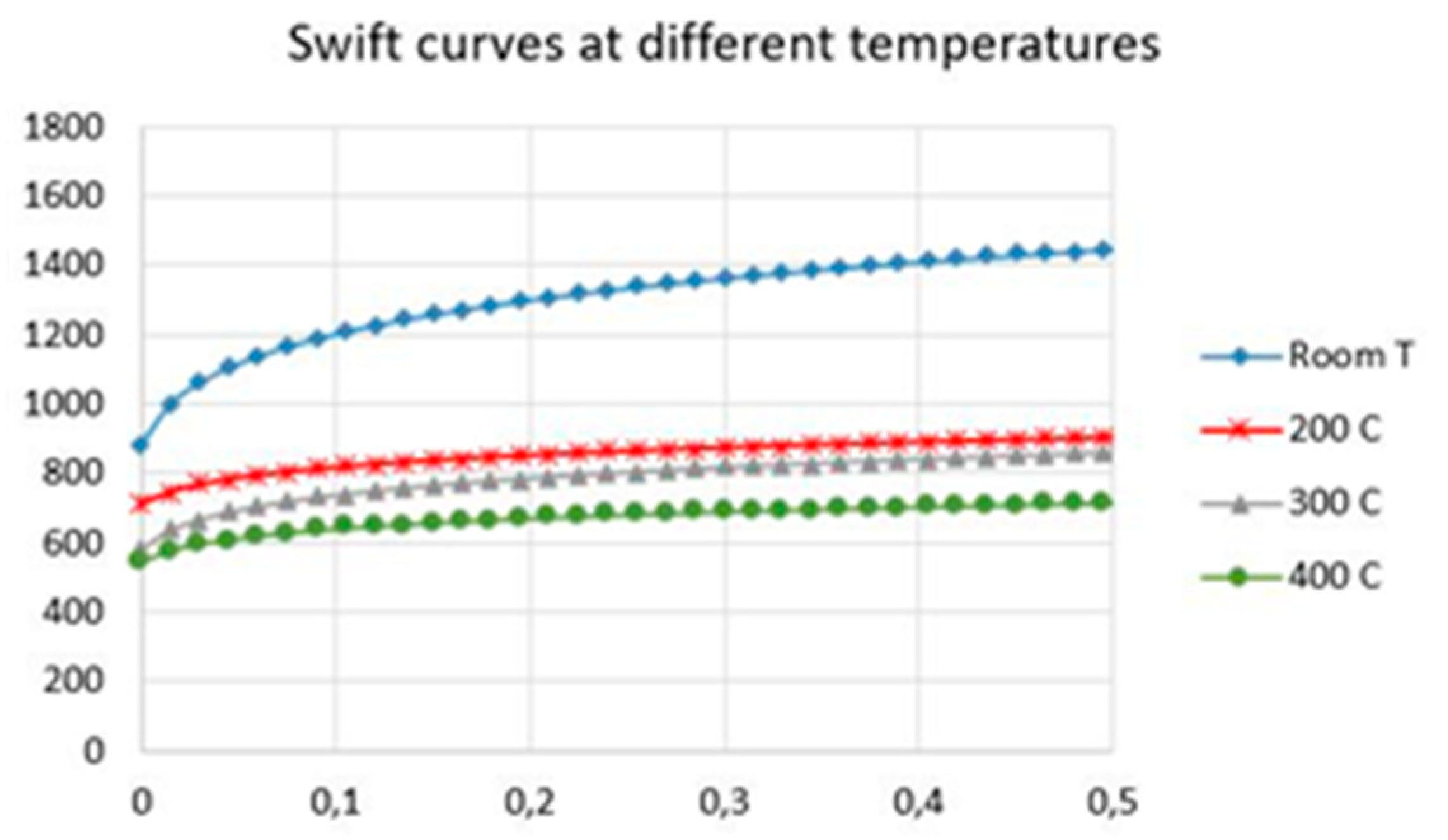


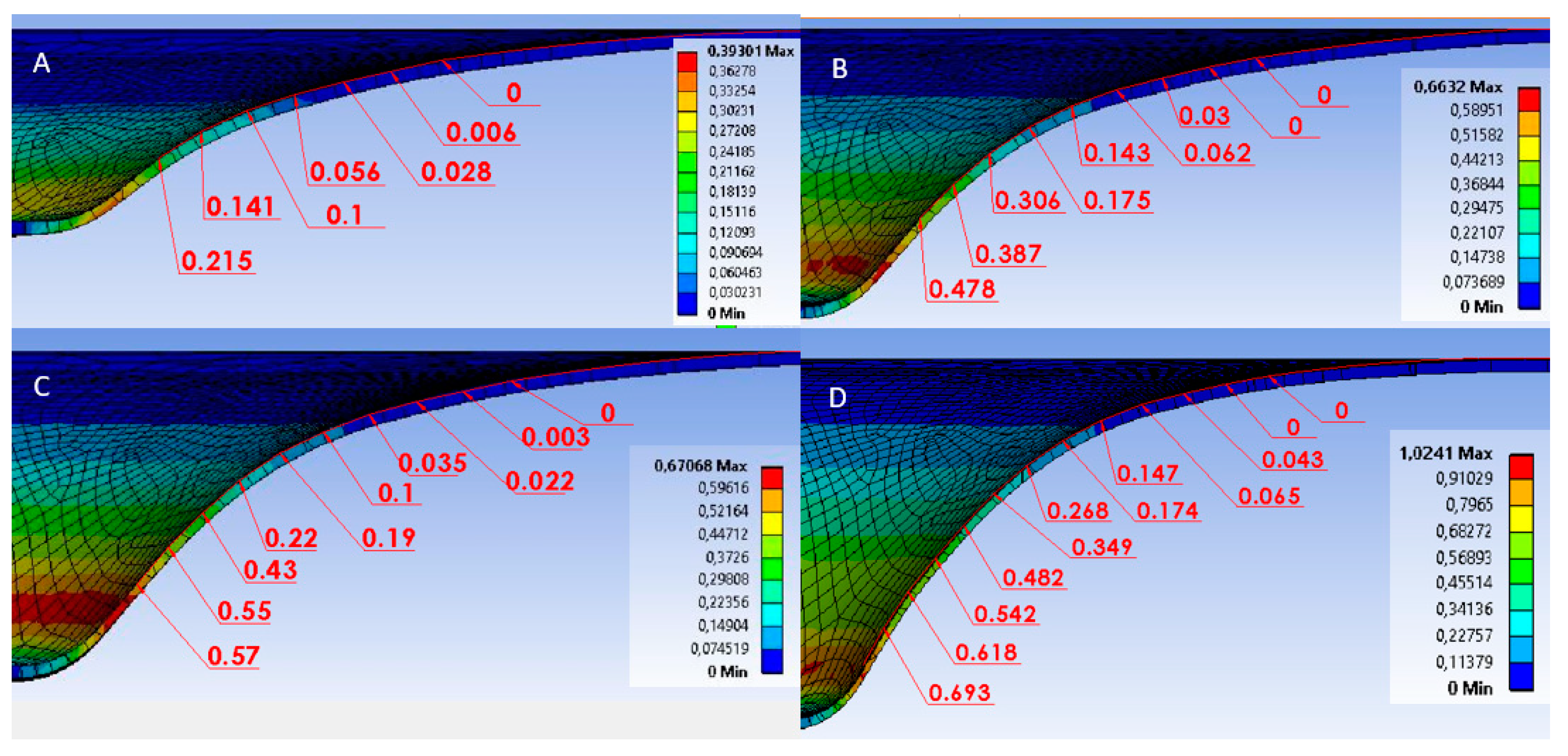

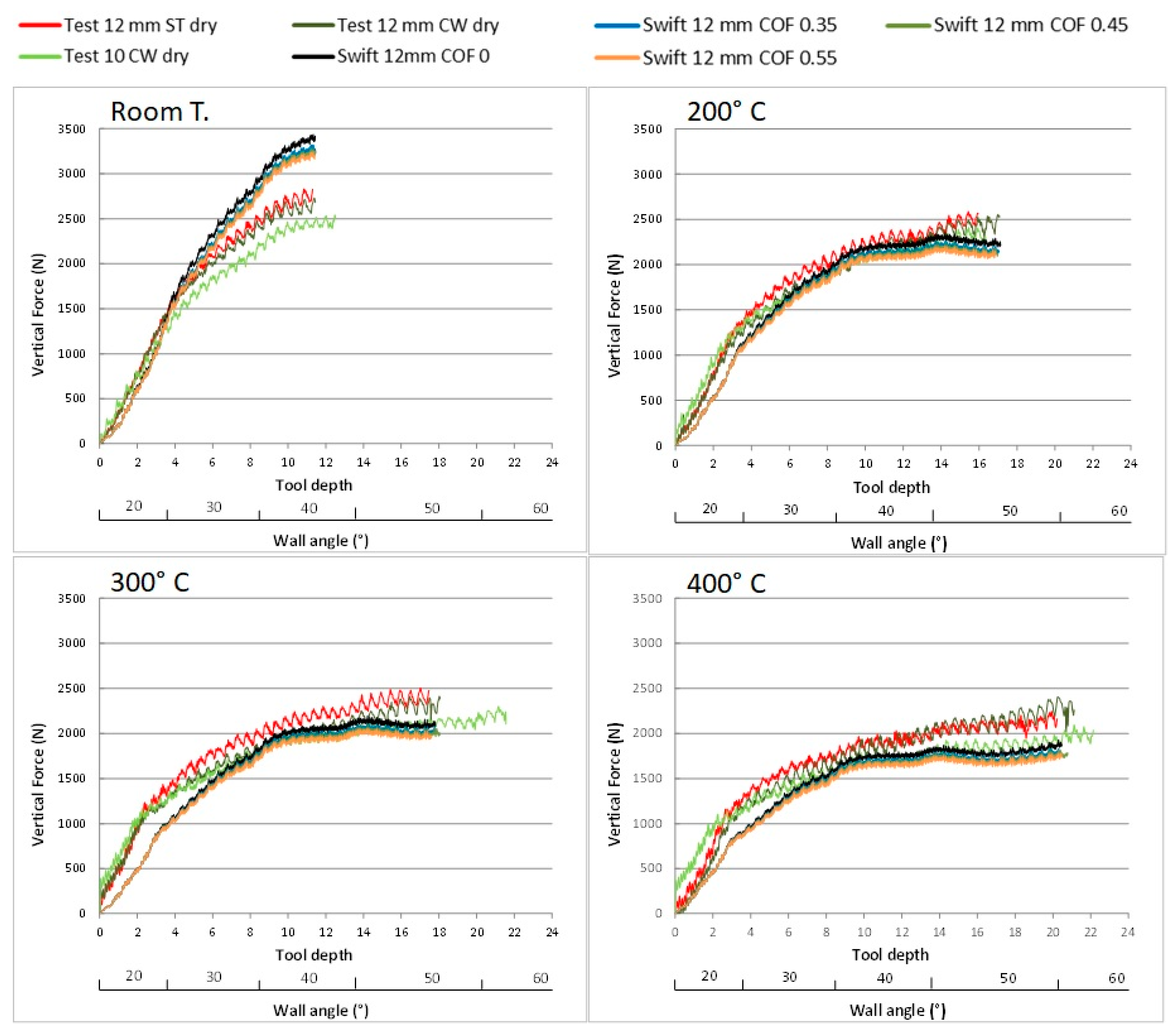




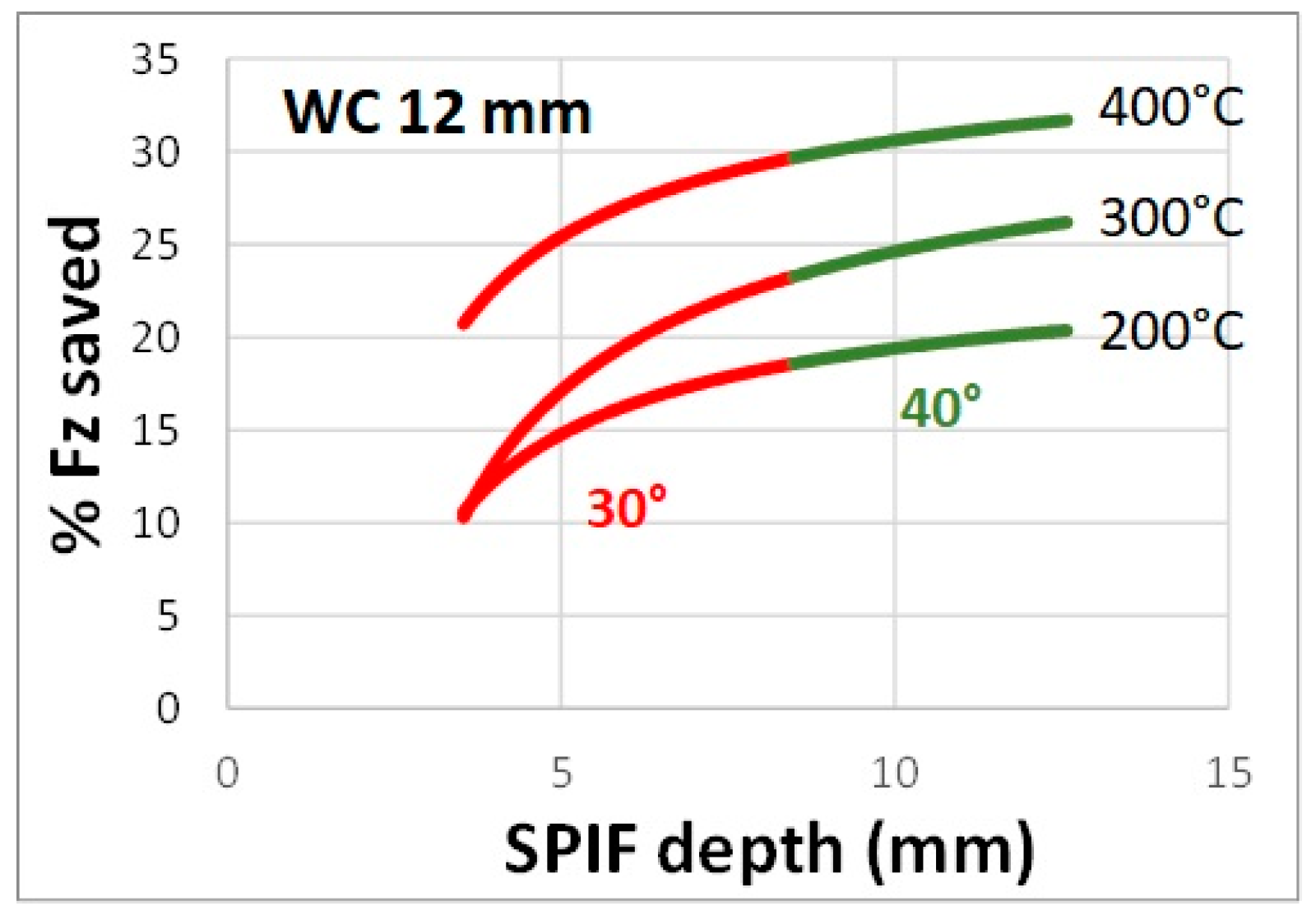


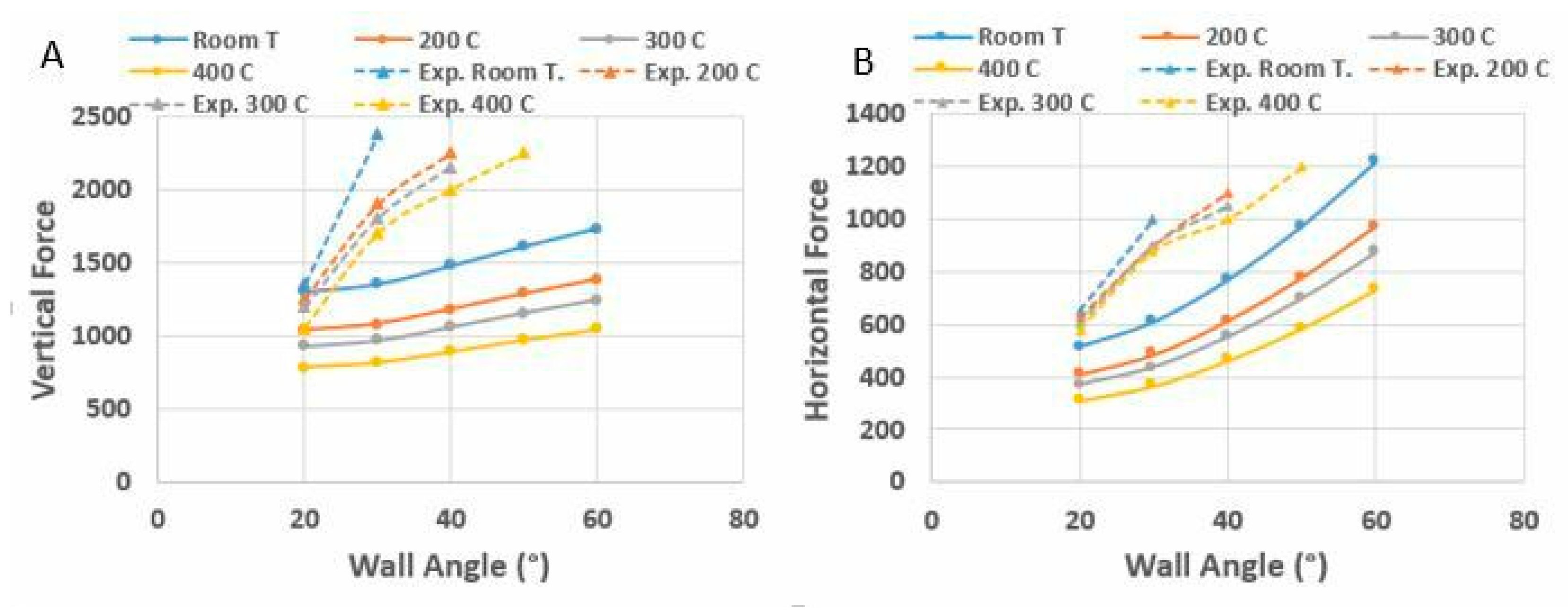
| Property | Room Temp. | 150 °C | 300 °C | 450 °C |
|---|---|---|---|---|
| Modulus of elasticity (MPa) | 108,158 | |||
| UTS (MPa) | 1190 | 829 | 694 | 583 |
| Yield stress (MPa) | 970 | 774 | 580 | 522 |
| True deformation for yield stress | 0.018 | 0.0163 | 0.010 | 0.012 |
| Hardening coefficient | 0.112 | 0.051 | 0.100 | 0.055 |
| Coefficient K | 1571 | 955 | 917 | 667 |
| Mean anisotropy | 1.31 | 1.72 | 1.31 | 1.05 |
| Anisotropy at direction 0° | 0.95 | 0.93 | 0.76 | 0.65 |
| Anisotropy at direction 45° | 2 | 2.2 | 1.73 | 1.38 |
| Anisotropy direction 90° | 1.03 | 1.56 | 1.01 | 0.8 |
| Test | Temp. (°C) | Angle (°) | Max Fz (N) | Max. depth (mm) | Pitch (mm) | Tool (Diameter_(mm)/Material) | Finished | Lubricated |
|---|---|---|---|---|---|---|---|---|
| 1 | 400 | 40 | 1920 | 18 | 0.5 | 12/WC | Yes | No |
| 2 | 400 | 45 | 1900 | 18 | 0.5 | 12/WC | Yes | No |
| 3 | 400 | 50 | 1950 | 12 | 0.5 | 12/WC | No | No |
| 4 | 400 | 60 | 1950 | 9.5 | 0.5 | 12/Steel | No | No |
| 5 | 300 | 40 | 2200 | 18 | 0.5 | 12/Steel | Yes | No |
| 6 | 300 | 40 | 2300 | 18 | 0.5 | 12/Steel | Yes | No |
| 7 | 300 | 50 | 2200 | 11 | 0.5 | 12/Steel | No | No |
| 8 | 300 | 50 | 2200 | 12.5 | 0.5 | 12/Steel | No | No |
| 9 | 300 | 50 | 1850 | 9.7 | 0.25 | 12/Steel | No | No |
| 10 | 300 | 50 | 1850 | 11 | 0.25 | 12/Steel | No | No |
| 11 | 300 | 60 | 2150 | 9 | 0.5 | 12/Steel | No | No |
| 12 | Room | 30 | 2600 | 25 | 0.5 | 12/Steel | Yes | Yes |
| 13 | Room | Var (30°) | 2750 | 11.3 | 0.5 | 12/Steel | No | No |
| 14 | Room | Var (30°) | 2650 | 11.4 | 0.5 | 12/WC | No | No |
| 15 | 200 | Var (40°) | 2400 | 15.6 | 0.5 | 12/Steel | No | No |
| 16 | 200 | Var (40°) | 2300 | 17.1 | 0.5 | 12/WC | No | No |
| 17 | 300 | Var (40°) | 2500 | 17.5 | 0.5 | 12/Steel | No | No |
| 18 | 300 | Var (40°) | 2400 | 18.1 | 0.5 | 12/WC | No | No |
| 19 | 400 | Var (50°) | 2100 | 20.2 | 0.5 | 12/Steel | No | No |
| 20 | 400 | Var (50°) | 2250 | 21.1 | 0.5 | 12/WC | No | No |
| 21 | Room | Var (30°) | 2400 | 12.5 | 0.5 | 10/WC | No | No |
| 22 | 200 | Var (40°) | 2300 | 16.3 | 0.5 | 10/WC | No | No |
| 23 | 300 | Var (50°) | 2200 | 21.5 | 0.5 | 10/WC | No | No |
| 24 | 400 | Var (50°) | 1900 | 22.1 | 0.5 | 10/WC | No | No |
© 2019 by the authors. Licensee MDPI, Basel, Switzerland. This article is an open access article distributed under the terms and conditions of the Creative Commons Attribution (CC BY) license (http://creativecommons.org/licenses/by/4.0/).
Share and Cite
Naranjo, J.A.; Miguel, V.; Martínez, A.; Coello, J.; Manjabacas, M.C. Evaluation of the Formability and Dimensional Accuracy Improvement of Ti6Al4V in Warm SPIF Processes. Metals 2019, 9, 272. https://doi.org/10.3390/met9030272
Naranjo JA, Miguel V, Martínez A, Coello J, Manjabacas MC. Evaluation of the Formability and Dimensional Accuracy Improvement of Ti6Al4V in Warm SPIF Processes. Metals. 2019; 9(3):272. https://doi.org/10.3390/met9030272
Chicago/Turabian StyleNaranjo, Jesús Andrés, Valentín Miguel, Alberto Martínez, Juana Coello, and María Carmen Manjabacas. 2019. "Evaluation of the Formability and Dimensional Accuracy Improvement of Ti6Al4V in Warm SPIF Processes" Metals 9, no. 3: 272. https://doi.org/10.3390/met9030272






